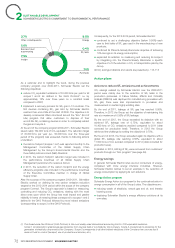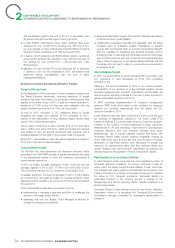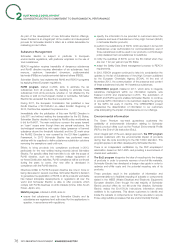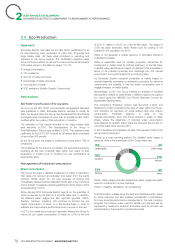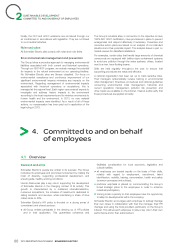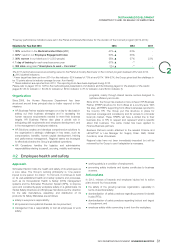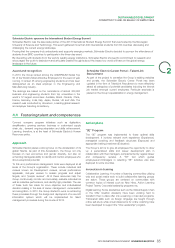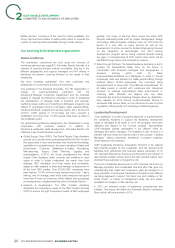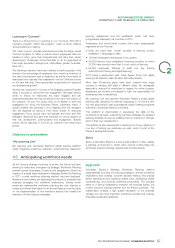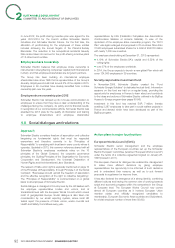APC 2013 Annual Report Download - page 84
Download and view the complete annual report
Please find page 84 of the 2013 APC annual report below. You can navigate through the pages in the report by either clicking on the pages listed below, or by using the keyword search tool below to find specific information within the annual report.
2SUSTAINABLE DEVELOPMENT
COMMITTED TO AND ON BEHALF OF EMPLOYEES
The resulting action plans have improved the processes and
Certifications
procedures involving job site safety, electrical safety, the In2009, Schneider Electric began the implementation of
management of PITs, and the safe servicing of equipment, which occupational health and safety management systems that meet or
has led to consistent, global application of these practices. Many exceed the requirements of ILSO/OHSAS 18001 standards.
of the most serious injuries occurred when an employee was In2011, the Group revised the requirement to specifically include
travelling between work and home. For this action plan, the focus certification to OHSAS 18001 (or equivalent) at 100percent of its
was on reviewing the risks around our sites and communicating manufacturing and logistics sites (sites with more than 50people
about safe commuting practices. Schneider Electric deployed a and within two years of creation or acquisition). The deployment of
campaign consisting of communication activities and built an this program is 78percent complete at end of2013.
internal online training course to help reduce the potential for
commuting incidents.
Training and Communication
Additional actions for 2013 included: Training and communication are key components of the
Safety Alerts – the introduction of a global alert system to quickly
l
Health&Safety program at Schneider Electric. The Group is
communicate serious events and their associated corrective committed to providing awareness level and task specific training
actions; for its employees and contractors to ensure a strong knowledge
Annual Safety & Environmental Assessments (ASEA) – the action
l
base to work safely. In 2013, a new emphasis has been placed on
plan was to continue to implement the ASEA globally; the ASEA ensuring all employees receive a minimum of seven hours of
is an internal audit system focused on critical safety and training per year (see page84), including OHS related training.
environmental elements that are applied on a global basis to New global safety courses continue to be added to the safety
ensure conformance to standardized OHS and environmental training program housed in the global training database, My
processes, practices and procedures; Learning Link, which tracks course requirements and course
completions.
Schneider Production System (SPS) – to ensure continuous
l
improvement in safety and ergonomic programs, phase I of the Communication is vital to an effective global OHS program and we
SPS action plan was released in 2013; the action plan includes are using many communication methods to share OHS concerns,
a global focus on key ergonomic themes such as work best practices, successes and more. New communication
practices, training, material handling and communications; opportunities implemented in 2013 include a new web-based tool,
Spice, and a document sharing tool, Box. Training and
GlobES (Global Environment and Safety) – this is the first full
l
communication has also been improved through the use of
year for the implementation of the new safety and environmental
webinars covering safety related training topics, performance
data management system;
reports, and action plan updates. Most of these webinars are
OHSAS18001.
l
recorded for continued use as training material and are shared on
Objectives
a global basis. Regional newsletters, global performance results,
Safety & Environment alerts, training material and more can be
Schneider Electric uses three primary indicators to measure found on the website, strengthening the OHS ties between
Occupational Health&Safety performance. The first of these countries and regions.
indicators is the Medical Incident Rate (MIR) which measures the
Focus on stress management
number of medical cases permillion of hours worked. This
measure allows for a deep evaluation of workplace hazards, and Stress at work is managed by the Human Resources organization
the resulting corrective actions assist in the elimination of recurring within the Group. Effective measures are in place locally to address
incidents and the prevention of injury. The Group has used the MIR stress reduction in the workplace. In North America for example,
as a key performance indicator on a global basis since2010 with a Human Resources promotes stress reduction via incentives and
target to reduce the MIR by 10% year over year. communications on the healthy lifestyle program in place (exercise,
The second and third indicators are the Lost-time Incident Rate proper diet, smoking cessation, stress management, preventative
(LTIR) and the Lost-time Day Rate (LTDR). The LTIR measures the medicine,etc.) which is encouraged both on and off the job. In
number of medical cases that incur lost-time work days permillion Asia Pacific, Human Resources promotes stress reduction via
hours worked. These lost-time cases are indicators of a more health lectures, yoga class, sports club, stretching program and
serious type of medical case. The seriousness of these cases is annual health fairs.
indicated by the LTDR which measures the number of days lost In France, a special program is in place to focus on psychosocial
due to the lost-time medical cases permillion hours worked. risks induced by stress at work, with the identification and the
Schneider Electric has used the LTIR and LTDR as key address of risk factors. Schneider Electric has developed and
performance indicators on a global basis since2012, replacing deployed a management tool to prevent psychosocial risks. It
similar indicators at that time. Both indicators also have a target includes a training module, a collection of indicators and a reading
reduction of 10% year over year. guide to identify factors contributing to psychosocial risks in a work
The 2013 results for MIR, LTIR and LTDR are as follows: organization. So far, 39sites have received training, 28 are under
MIR 2012 =3.44; MIR 2013 =2.36; reduction of 31%;
l
diagnoses, and 25 are implementing corrective action plans. A
second management tool is deployed to maintain employment for
LTIR 2012 =1.42; LTIR 2013 =1.18; reduction of 17%;
l
people with occupational health problems and prevent the sources
LTDR 2012 =47.98; LTDR 2013 = 38.67; reduction of 19%.
l
of work stress that may impact physical and mental health. An
agreement on the prevention of the psychosocial risks has been
signed by the management and unions and defines a framework
for the action plans to deploy within Schneider Electric Industries
and Schneider Electric France. Creating awareness among
employees, managers and RH is a priority of the 2013 training
82 2013 REGISTRATION DOCUMENT SCHNEIDER ELECTRIC


